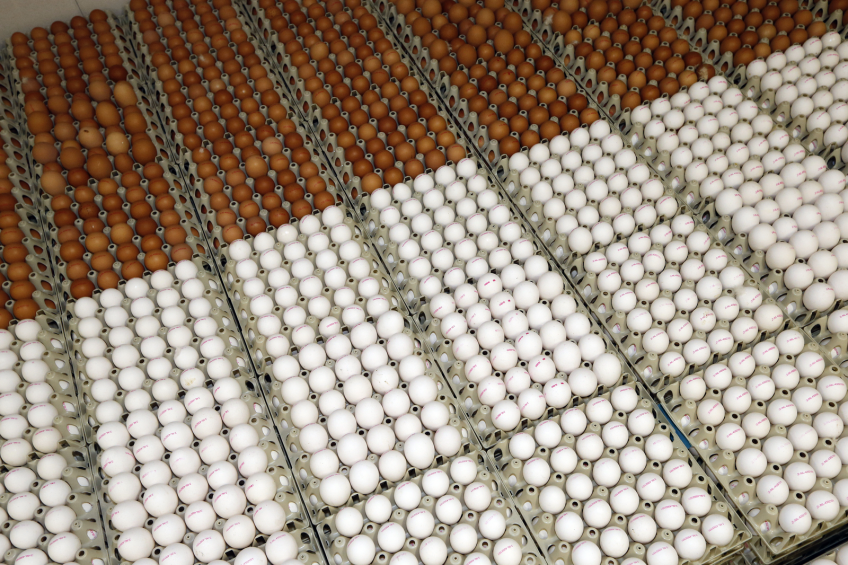Reviewing 50 years in the egg industry

The International Egg Commission (IEC) is a unique organisation that is ?keeping track of worldwide egg production, trade and consumption patterns and dynamics. This year IEC is celebrating its 50th anniversary. A good reason for reviewing the history and development of the global egg business over the ?past 50 years based on the situation in Denmark, the Netherlands and the USA. This also explains todays trends.
By Peter van Horne, IEC economic analyst, Wageningen UR, the Netherlands In cooperation with Donald Bell*, Poultry Specialist (emeritus), University of California Cooperative Extension (USA), and Jørgen Nyberg Larsen and Leo Yding Sørensen, Danish Poultry Council (Denmark)
The International Egg Commission (IEC) was founded in 1964. Celebrating 50 years of IEC gives the opportunity to look back and overview the development of the egg sector. Information was collected from several countries to illustrate this development. We searched for information on performance of layer flocks, prices of feed and eggs, production costs and consumption levels.
Unfortunately most countries only have data on the last 20 or 30 years. Only from Denmark, USA and the Netherlands were we able to collect data covering the last 50 years. The information is mainly based on the development at farm level. Information on the development in egg packing and egg processing was unavailable. This article reviews the development over 50 years from 1962 till 2012. Prices are given as nominal values, without any correction for inflation.
Performance layers at farm level
Based on Danish data an overview of the performance at farm level over the period 1962-2012 is available. Data on laying percentage, feed conversion and mortality rate from 1962 are documented. These data are based on information collected on Danish farms. The housing systems in Denmark logically changed over time. In the early sixties floor systems were used and in the late sixties the production gradually changed to the Pennsylvania sloping netting floor system. From 1985 the figures are from hens kept in cages. All these data are based on non-molted flocks.
Figure 1 gives and overview of the laying percentage (average hen-day egg production) during the period 1962 till 2012. The figure clearly shows the impressive progress in productivity of the hens. In the sixties, laying percentage was around 60%. Especially in the seventies and eighties there was a remarkable progress, developing from 62% in 1970 towards 83% in 1990. In the years from 1991 there was a further steady increase towards 92% in 2012. On average the increase in laying percentage between 1962 and 2012 was 0.67% per year. This development was mainly driven by better genetics, improved layer feed and better husbandry practices.
Lower FCR and mortality
Also feed conversion ratio (FCR) changed dramatically between 1962 and 2012. In the sixties FCR on Danish farms was around 3.5: for every kilogram of eggs an amount of 3.5 kg of feed was needed. In recent years FCR went below 2.0, with the exact ratio of 1.96 in 2012 in Denmark. Driven by the increase in egg production, as shown in Figure 1, feed conversion especially showed a rapid improvement in the
seventies and eighties.
Moreover mortality rates went down substantially on Danish farms between 1968 and 2012. Exact data for the period 1962 to 1968 are lacking, but experts state that mortality rates in this period were around 20%. From 1968 onwards mortality rates decreased towards lower levels in the nineties. Due to disease problems the mortality rates between years may fluctuate. In recent years mortality on Danish farms went down to below 4%.
Fluctuating feed prices
Feed costs are the main component of the production costs of eggs. Feed prices from three countries were collected: Denmark, the Netherlands and USA. Figure 2 illustrates the trend in feed prices of layer feed in Denmark. These are given in Danish Krones per 100 kg of feed. Here, feed prices increased between 1973 (87.8 Dkr) to a high level in 1984 (224.5 Dkr). In this period the European Union had a common market policy in which prices of feed ingredients were guaranteed by intervention prices. Starting in 1992 the EU intervention prices of grains were reduced, resulting in lower poultry feed prices. Since the liberalisation of the EU, grain market feed prices are influenced by world market prices. From 2008 onwards there was an increase in feed price. In 2012 feed prices in Denmark were at an all-time record of 229 Dkr per 100 kg.
In the Netherlands, the feed price development was somewhat similar to Denmark. However, prices in the Netherlands nowadays, are given in euros per 100 kg of feed. Before 2002 these prices were expressed in Dutch guilders and all these prices have been recalculated into euros (2.2 guilder per euro). For the period before 1980 only five year average data were available. In the Netherlands feed prices increased between 1971 (21.5 euro) to a record high level in 1983 (32.2 euro). From 2008 there was an increase in feed price resulting in a feed price of 29.5 euro per 100 kg in 2012.
No government interference
Figure 3 gives the development of the layer feed price in Southern California, USA. The feed price is given in US$ per 100 pound. Feed prices in the USA increased more steadily over time. Different from Denmark and the Netherlands, there was no price peak in the beginning of the eighties. The US feed price is based on world market prices without any government interference. The prices of layer feed increased gradually over the years from US$ 2.90 in 1962 towards US$ 8.0 per 100 pound in 2006. From 2006 feed prices increased with a peak in 2008 (US$ 13.8) and an all-time record high prices in 2012 of US$ 16.9 per 100 pounds.
Egg price variances
Egg prices were collected at farm level from the same three countries: Denmark, the Netherlands and USA.
Figure 4 gives egg prices at farm level from 1962 till 2012 in Denmark in Dkr per kg eggs. In the sixties and seventies the egg price at farm level increased from 2.8 in 1962 to 8.5 in 1984. In this year also the feed price peaked at its highest level. From 1984 onwards the egg prices decreased and prices fluctuated between years. From 2008 egg prices increased again following the rapid increase in feed price.
In the Netherlands, for a long period egg prices were fluctuating between 0.80 and 100 euro cent per kg. In 1981 the egg prices was at the highest point of 1.16 euro per kg. Since then egg prices went down, with regular fluctuations in between years. In recent years egg prices fluctuated with high egg prices in 2009 (German ban on traditional cages) and 2012 (EU ban on traditional cages).
Figure 5 gives egg prices at farm level (in US$ per dozen eggs) from 1962 till 2012 in the United States. Because there is no price range available for the 50 year period in Figure 5, two prices are given each for a different time period. Although there are differences in price level for the US and Southern California, we can analyse the development in egg price over the 50 year period. In the sixties the Southern California farm egg price was around US$ 30 per dozen. During a long period between 1973 till 2005 prices in the USA fluctuated between US$ 40 and 60 per dozen. From 2007 egg prices were at high levels.
Production costs
Production costs are calculated on a yearly basis by LEI Wageningen UR for the Netherlands and the EIC in Iowa (Don Bell and Maro Ibarburu) for the USA. The method of calculation can be different and also the units are not comparable. For both countries the production costs are presented for the period 1962 till 2012. Figure 6 gives the production costs for the production of 100
eggs in the Netherlands. The costs are including the cost for pullets, feed, other variable costs and the fixed costs for housing and equipment.
Labour costs of the farmer are excluded. Till 2002 in the Netherlands the currency was Dutch guilders. For the whole period the costs are re-calculated in euros (2.2 guilder is one euro). Between 1962 and 1980 the production costs were between 5 and 6 euros per 100 eggs. From 1983 there was a steady decrease in production costs. As feed costs are the main cost component, the development in production costs is similar to the development in feed price.
Figure 7 illustrates the development in the production costs in Southern California. For a long period, between 1973 and 2005 the production costs were 40 to 60 US$ cent per dozen. From 2006 production costs increased as a result of higher feed prices.
Purchasing power
It’s clear that in the period 1962 till
2012 the level of welfare and standard of living in Europe and the USA did increase. The hourly wage for workers in the industry is a good indicator for this. Data from Denmark show that the hourly wage in the industry was 8.7 Dkr in 1962. Already in 1969 this was doubled (18.6 Dkr), then again doubled in 1975 (39 DKr), in 1983 (83 Dkr) and in 1997 (161 Dkr). In 2012 the average wage was 269 Dkr per hour. This is 31 times the wage in 1962. To illustrate the development in purchasing power of the worker we calculated the number of eggs (farm level price) a worker can buy of his hourly wage. Figure 8 shows the development over the period 1962 till 2012. In 1962 a worker could buy 49 eggs for a hourly wage and in 2012 this number was 516. More than 10 times more
eggs can be bought for the same hour
of work.
Consumption patterns
From IEC data it is known that egg
consumption (eggs per capita per year) varies widely between countries in the world. For this review we collected data of consumption in again the three
countries for the period 1962 till 2012. Egg consumption in Denmark increased towards a level of 230 eggs in the seventies and eighties. In the Netherlands, egg consumption decreased in the years between 1962 and 1972 as can be seen from Figure 9. In the eighties consumption was slightly higher for a period and after that had a period with decreasing consumption. This was probably a result of the discussion on cholesterol in eggs. Since 1992 egg consumption is slowly but steadily increasing.
In the US there was a decline in egg consumption between 1962 and 1990. On average, 320 eggs were consumed in 1962 and in 1991 that number was 234. Since 2000 the consumption is between 248 and 258.
* Shortly after having contributed to this article, Don Bell passed away. World Poultry is thankful for his contribution to the egg industry
WP, Volume 30, issue 9, 2014













